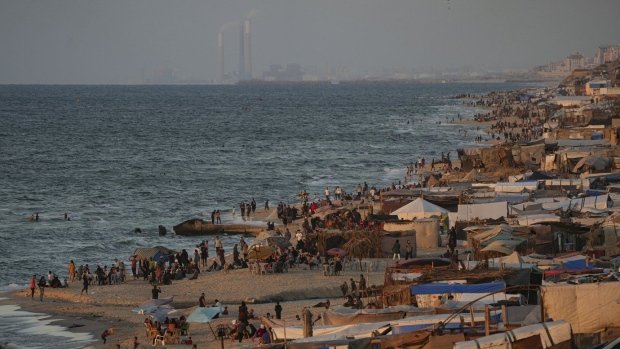[ad_1]
DEIR AL-BALAH, GAZA STRIP —
An Israeli strike on a school sheltering the displaced in the Gaza Strip killed at least 27 people on Thursday, Palestinian medical officials said. The Israeli military said it targeted militants hiding among civilians, without providing evidence.
Israel has continued to strike at what it says are militant targets across the Palestinian enclave even as attention has shifted to its war against Hezbollah in Lebanon and rising tensions with Iran. The military launched a large-scale air and ground operation against Hamas in northern Gaza earlier this week.
In a separate development, the UN peacekeeping force in southern Lebanon said an Israeli tank fired on its headquarters in the town of Naqoura, hitting an observation tower and wounding two peacekeepers, who were hospitalized.
The Israeli military said it was looking into the incident.
UNIFIL said in a statement that its headquarters and nearby positions “have been repeatedly hit.” It said the army also fired on a nearby bunker where peacekeepers were sheltering, damaging vehicles and a communication system. It said an Israeli drone was seen flying to the bunker’s entrance.
Strike on shelter appears to have targeted Hamas-run police
The strike in the central Gaza city of Deir al-Balah killed 27 people, including a child and seven women, according to the Al-Aqsa Martyrs Hospital, where the bodies were brought. It said several other people were wounded.
An Associated Press reporter saw ambulances streaming into the hospital and counted the bodies, many of which arrived in pieces.
“We appeal to the world. We are dying!” one man screamed.
The Israeli military said it carried out a precise strike targeting a militant command and control center inside the school. Israel has repeatedly attacked schools that were turned into shelters in Gaza, accusing militants of hiding out in them.
Witnesses who spoke on condition of anonymity for security reasons said the strike occurred while school managers were meeting with representatives of an aid group in a room normally used by Hamas-run police who provide security. They said there were no police in the room at the time.
The Hamas-run government operated a civilian police force numbering in the tens of thousands. They largely vanished from the streets after the start of the war as Israel targeted them with airstrikes, but plainclothes Hamas security personnel still exert control over most areas.
Hamas has continued to launch attacks on Israeli forces and fire occasional rockets into Israel more than a year after its Oct. 7 attack ignited the war.
Hamas-led militants stormed into Israel and rampaged through army bases and farming communities in that attack, killing some 1,200 people, mostly civilians, and abducting around 250 others. They are still holding around 100 captives, a third of whom are believed to be dead.
Israel’s offensive has killed over 42,000 Palestinians, according to local health authorities, who do not say how many were fighters but say women and children make up more than half of the fatalities. The war has destroyed large areas of Gaza and displaced around 90 per cent of its population of 2.3 million people, often multiple times.
UN peacekeepers caught in intensified fighting in Lebanon
UNIFIL, which has more than 10,000 peacekeepers from dozens of countries, was created to oversee the withdrawal of Israeli troops from southern Lebanon after Israel’s 1978 invasion. The UN expanded its mission following the 2006 war between Israel and Hezbollah, allowing peacekeepers to patrol a buffer zone set up along the border.
Israel accuses Hezbollah of establishing militant infrastructure right along the border in violation of the UN Security Council resolution that ended the 2006 war. It has warned people to evacuate from dozens of communities in southern Lebanon, many of which are outside the buffer zone.
The UN peacekeeping chief, Jean-Pierre Lacroix, said last week that UN peacekeepers were staying in their positions on Lebanon’s southern border despite Israel’s request to vacate some areas before it launched its ground operation against Hezbollah.
Hezbollah began firing rockets into Israel on Oct. 8, 2023, in support of Hamas and the Palestinians, drawing Israeli airstrikes in retaliation.
The fighting steadily escalated, and eventually boiled over into all-out war in recent weeks, with Israel carrying out waves of heavy strikes across Lebanon and launching the ground invasion. Hezbollah has expanded its rocket fire to more populated areas deeper inside Israel, causing few casualties but disrupting daily life.
Israel says the ground invasion, which has so far focused on a narrow strip along the border, is aimed at pushing the militants back so that tens of thousands of Israelis can return to their homes in the north. The fighting has displaced over a million people in Lebanon.
Iran supports Hamas, Hezbollah and other armed groups across the region that refer to themselves as the Axis of Resistance against Israel. Iran launched some 180 ballistic missiles at Israel last week in retaliation for the killing of top Hamas and Hezbollah militants.
Israeli Defense Minister Yoav Gallant said Wednesday that its response to the Iranian missile attack will be “lethal” and “surprising,” without providing further details, as Prime Minister Benjamin Netanyahu spoke with U.S. President Joe Biden.
Magdy reported from Cairo. Associated Press writers Kareem Chehayeb in Beirut and Melanie Lidman in Tel Aviv, Israel contributed.
[ad_2]
Source link
Share this content:
